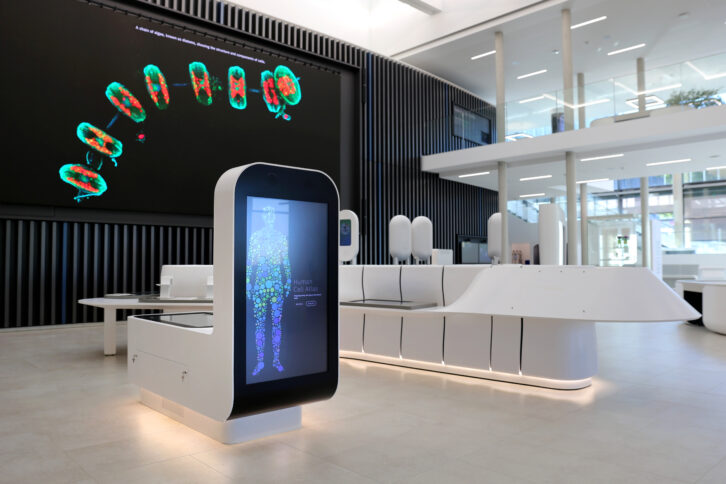In the wake of the pandemic era – where so much attention was, inevitably, given to communications & conferencing technology, and its role in helping companies to continue functioning effectively – it’s not surprising that so much discussion about corporate AV has revolved around the enabling of remote and hybrid working. But while technologies that support more flexible working patterns remain a significant target of investment, they are far from being the ‘only game in town’.
In this article, we’ll look at some of the other areas currently competing for corporate budgets, including building control & management systems, LED displays and lighting, and – perhaps most intriguingly in terms of its long-term potential – virtual production. Whilst it’s not easy to generalise about such a disparate set of technologies, it is possible to see them as part of a ‘reboot’ of the corporate experience as companies look to optimise the time that staff – and visitors – spend on-site, as opposed to the increasing number of days when they are likely to be based at home.

There is also a recurring thread here of organisations wanting to use technologies that are conducive to wellness, especially in lighting where a tradition of supporting research is now well-advanced.
UPWARD TRAJECTORY
Common to the interviews conducted for this article was the sentiment that – assisted to some degree by enforced ‘downtime’ during 2020-21 – many companies have felt inspired to conduct root-and-branch-style reviews of their AV needs, both now and how they are likely to be several years hence.
Dirk Noy is partner, director of Applied Science and Engineering at WSDG, which is an international company specialising in architectural acoustic consulting and media systems engineering. Mainly focused on larger spaces such as boardrooms, auditoria and medium-to-large meeting spaces, WSDG initially helps clients assess their needs by formulating and analysing use cases and scenarios.
“Corporate AV has a clear upward trajectory,” declares Noy. “Large internationally operating corporations have had significant AV infrastructures as long as they have existed. Now, the company-size-threshold rolls down to even a small corporation with only a few employees – they all need at least some minimal AV infrastructure, even if it’s just a huddle room with a display and a ‘VC bar’ or a decent headset.”
“In general, I think that companies are now, more than ever, completely re-evaluating all of their workspaces and reassessing the best applications for how they set those up for the new ways of working,” says Adam Dover, corporate marketing manager, Sony Europe.
Of course, although the willingness to invest might be there, that doesn’t mean it’s always possible. Max Winck, marketing director at LED displays and lighting company Leyard, suggests that the corporate market has “returned to pre-Corona levels”, but adds that “momentum flattened somewhat” due to Russia’s attack on Ukraine and the associated energy crisis and accompanying inflation in many European countries. As of mid-2024, the investment picture remains varied.
Winck observes: “The slowdown in growth in China is leading to more investment there, America and Europe are relatively stable, while great expectations are being placed in the Middle East, particularly in the Kingdom of Saudi Arabia, which is currently particularly keen to invest.”
No one should feel too confident about predicting the future, especially at the moment, and you don’t have to look too far for factors that could impact upon the ability to invest. But for now, at least, plenty of corporations are able to assign significant budget for new AV – so how exactly are they spending it?
AT SCALE
Although hybrid working is not the focus of this article, AV management systems can have significantly broader reach, sometimes encompassing entire buildings or estates. So one consequence of the review period at many companies appears to have been an increased awareness of the contribution that unified control and collaboration platforms can make – whether or not an organisation has pivoted heavily towards remote working.
Brad Hintze, executive vice-president, global marketing at Crestron, remarks: “We see huge potential in solutions that combine the three essential needs of our customers: to collaborate and share content; to do so at scale; and to include the ability to control other aspects of the room. When hybrid work really started to take off, everybody focused on the virtual collaboration side of it — and with good reason, as our research shows that 85% of the calls have a virtual participant. But at the same time, you also want to be able to share content and collaborate when you’re all in a room together. That is an aspect of hybrid work that more people are starting to focus on.”

Core requirements among Crestron’s corporate customers – “for AV in general and control systems specifically” – are described as security, scalability, low cost of ownership and ease of management. Moreover, with the potential complexity of many corporate facilities increasing, it’s not hard to understand the appeal of a “single pane of glass to see the health and status of all their systems”.
Increasingly, the cloud is proving to be an important enabler. “Crestron’s Virtual Control VC-4 [software] and appliance-based 4-Series [control engine] seamlessly integrate into our management platform, XiO Cloud, which gives you visibility, as well as configuration, provisioning, and control of all your rooms and system. And with the new Program Connector, a control system also provides more system-level detail to XiO Cloud, changing it from a device management platform to a system management platform. The impact of cloud-based infrastructure has moved many enterprises towards a more centralised control paradigm. Virtual Control is positioned exactly for that use case.”
The extent to which AV-oriented control systems should integrate with BMS (building control management systems) – eg. Systems used to control integral building infrastructure such as lighting, heating and air conditioning – has been a hot topic in parts of the industry for years. But with the cloud furnishing a more level playing-field, it seems inevitable that more vendors will want to offer control solutions that can address the full range of technologies within a building.
“It’s a new territory for many manufacturers,” says Hintze, “but as buildings become more and more integrated, and they have more and more technology, customers want those systems to be talking together and reaching that scale. We expect a focus on integrating AV and UC technology in the building management system. The sky is the limit there.”
He provides an example scenario involving an external visitor arriving for a meeting. “When they enter the parking lot, their licence plate is recognised, and wayfinding directs them to their parking spot, past the reception desk towards the correct meeting room. At the same time, you get an alert that your visitor has arrived so you can walk to the meeting room, which is exactly at your preferred temperature [and] with your preferred brightness. HVAC isn’t in overdrive since the blinds automatically closed because the sun was shining on the windows. And of course, the message on the display is welcoming your customer, ready to share content with one click.”
Hintze concludes: “That combination of IoT, AV, UC, control and automation all working together; that’s where the future of AV is.”
CORPORATE ASPIRATIONS
Whilst we’re gazing a little more fixedly into the middle distance, it seems logical to address another anticipated technology trend: virtual production (VP). Already well-established in film and television, VP employs technologies including augmented reality, CGI and motion capture to provide highly realistic environments and effects on virtual sets. Now it looks set to be applied in the corporate world to everything ranging from internal training to the production of presentations and global streaming events.
Sony is ideally placed to comment, with its more recent VP-related developments including the opening last year of a Virtual Production Space within its Digital Media Production Centre at Pinewood Studios, situated west of London. “It’s definitely a hot topic at the moment because we’ve obviously seen virtual production take off in the actual [film & TV] production market, then we saw it transition into educational spaces where universities are investing a lot in the technology that they have on campuses so they can offer the very best for their students and be attractive in that sense. And now we’re getting quite a few questions about how it could be best used in corporate environments” – with Dover going on to cite varied queries about the potential of VP for recruiting new talent as well as “improving and bolstering” corporate communications.

As might be expected, Sony is making plentiful use of VP itself, including for the production of training videos, webcasts and “smaller kinds of digital content”. Extrapolating this to a more general business context, Dover indicates that VP – when supported by a “dynamic studio space” – offers corporations valuable opportunities to “very quickly create highly professional content in a very cost-effective way because, in the example of promoting and reflecting a product or brand, they don’t have to go out and rent a third-party venue or anything.”
What Dover describes as the “flexibility element” of VP will continue to be critical. “We’re already seeing some larger companies who have both a number of smaller studios where they can create content on a more compact level, as well as kind of ‘flagship’ spaces with LED walls,” he says. “But I also predict a lot of companies [only] wanting smaller environments where they can produce their own content within an office, making it easier and more cost-effective for them.”
CJP specialises in virtual production studio integration, and recently appeared in Installation elaborating on the potential of VP in education. It’s reasonable to expect similar take-up in corporate as the principal advantages are so readily transferable. Kieran Philips, sales & marketing director of CJP, remarks: “The core benefit of [VP] – the ability to conjure up a complete environment which may be too fantastical to realise or too expensive to shoot in – at the click of a mouse in a controlled space is applicable in so many fields.”
But it’s a trend that is not without caveats. It remains a relatively new area of technology, and one where some solutions and practices are still coalescing, which can make it difficult to invest for the long-term. Perhaps even more critically, VP has grown so rapidly that it doesn’t yet have a skilled workforce large enough to realise all of the opportunities. Hence Philips’ identification of the challenges created by a “shortage of skilled and talented designers and operators to realise” VP projects.
That said, with plenty of plans in progress to greatly expand the availability of VP training (see this recent Installation article for more), it’s possible to see an end in sight to this particular problem.
Meanwhile, whether corporations are looking to enhance their media output through VP or not, the production values associated with all content are continuing to rise. With its distinguished history in solutions for broadcast, Imagine Communications is well-placed to observe the trend, with chief process officer Dr. Glodina Connan-Lostanlen agreeing that more and more companies are wanting to invest in broadcast-grade production equipment.
“It’s becoming a real segment with a lot of growth,” she confirms, pointing to a particular desire to invest among financial organisations and consumer tech companies. As well as wishing to establish high-spec “production environments, you’re also starting to see some playout applications as well, [so it’s all] very similar to how a broadcaster would create a programme with live and recorded content.”
HEALTH & WELLNESS
It’s hardly surprising that health and wellness should also be a higher priority after a pandemic that impacted normal working life so dramatically. But the rise in interest is also based in a now-extensive body of research covering the impact on physical and mental health – not to mention productivity – of the levels and type of lighting, air quality, environmental noise, and other factors.
In the context of meeting rooms, Dover says there has been “quite an uptake in the importance [placed on] health and wellness in those spaces”, including the use of technology that supports the creation of “very bright meeting rooms so they have that kind of energy. That’s immediately challenging for display technologies because you’ve got high brightness coming in so you’re automatically getting a lot of blur.” As a result, he says that “people are now really putting pen to paper” in terms of envisioning integrated and automated system designs that allow room configurations to be adjusted more easily, including for different light levels.
Staying on the topic of display walls, Leyard’s Max Winck indicates that lower price points have helped bring LED solutions within reach of a broader range of companies. “From the point of view of an LED manufacturer, it has to be said that the increasingly inexpensive products available in the narrow pixel pitch range have meant that not only large companies are prepared to invest here, but now also individual companies from the SME sector appreciate the advantages of this technology,” he says.

There is also a clear trend towards the use of LED walls as part of corporate facility branding, for the benefit of both employees and visitors. For example, a recent Leyard project on behalf of Belgian frozen potato product company Agristo revolved around the specification of an LED display solution for the new HQ building at its Wielsbeke production site, with Play AV supplying two complete set-ups of Leyard Europe MGP Complete Video Wall Display for the reception area and ‘the potato’ auditorium.
Winck – who notes that Leyard can provide complete solutions for LED video walls or All-In-One LED Display solutions that “make it easier for the customer to find the right product from the wide range available” – also highlights the increased profile of security matters: “The progressive blending of IT and AV systems is also leading to greater security awareness in the AV components used. In Europe, there is even a new security directive for display devices. The ETSI EN 303 645 is the first globally applicable standard for consumer IoT. The standard is designed to prevent large-scale, prevalent attacks against smart devices by establishing a security baseline for connected consumer products, in addition to providing a basis for future IoT certification schemes.”
American sister company Planar – whose LCD display solutions Leyard provides to the European market – recently announced that the Planar UltraRes W Series ultra-wide format LCD display and Planar Simplicity M Series 4K LCD display are its first commercial display offerings to be ETSI EN 303 645 certified.
Seemingly acknowledging the need to ensure SIs and customers get the most out of increasingly sophisticated systems, there is also plentiful evidence of expanded education efforts. For example, RGB Spectrum recently announced the launch of comprehensive training courses tailored for integrators, end-users, manufacturer representatives, consultants and other partners. The training curriculum encompasses various modules that offer detailed insights into key products such as the Galileo video wall processor and Zio platform, with participants able to access courses on-site at RGB Spectrum HQ or through the company’s e-learning system.
“We understand that continuous learning is vital in today’s dynamic landscape. That’s why we are committed to offering training opportunities that are not only comprehensive, but also accessible and flexible,” says Bob Marcus, CEO, RGB Spectrum.
AUDIO AWARENESS
If audio hadn’t always received its deserved attention in the corporate environment, the surge in remote working needs during the pandemic – where people suddenly became acutely aware that quality audio communications were essential to business continuity – surely rectified that. But now it seems that enhanced audio awareness is reaching other areas of corporate, with signs including an increased interest in acoustic treatments at company facilities.
For WSDG, Dirk Noy says that “awareness is being raised due to a number of trends that support each other”. The prevalence of hearing loss – in the US, the NCOA recently reported that it affects about 60.7 million Americans aged 12 and older – is one factor, as is the need for speech intelligibility to be high for in-room and remote participants, as well as at the remote site. Fortuitously, “high architectural integration of AV tech with room elements gives opportunities for placing acoustical materials (eg. displays surrounded flush with absorptive treatments, ceiling microphones integrated in ceiling panels, etc).”
Looking ahead, Noy expects there will be increasing take-up for better automated processing of multiple audio and video signals; signal distribution with reduced latency; and “much more focus on proper speaker tracking (audio and video) – the input signal acquisition simply must get better (mics and cameras), whilst the output signal reproduction is significantly less of an issue. AI is a hopeful candidate to better optimise/select/filter the ‘correct’ audio and video.”
There are several other emerging technologies that could have been covered in this overview, but the subtext is clear: there is presently an abundance of innovation occurring that means corporations can greatly enhance their AV both on-site and remotely. And at least for the foreseeable future, it seems there are plenty of companies with the resources to do just that.







